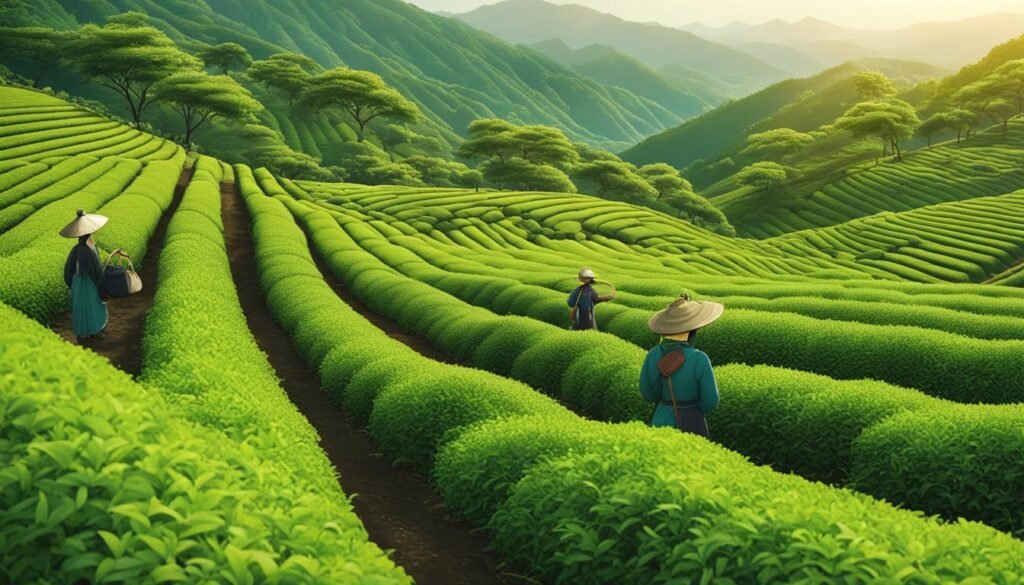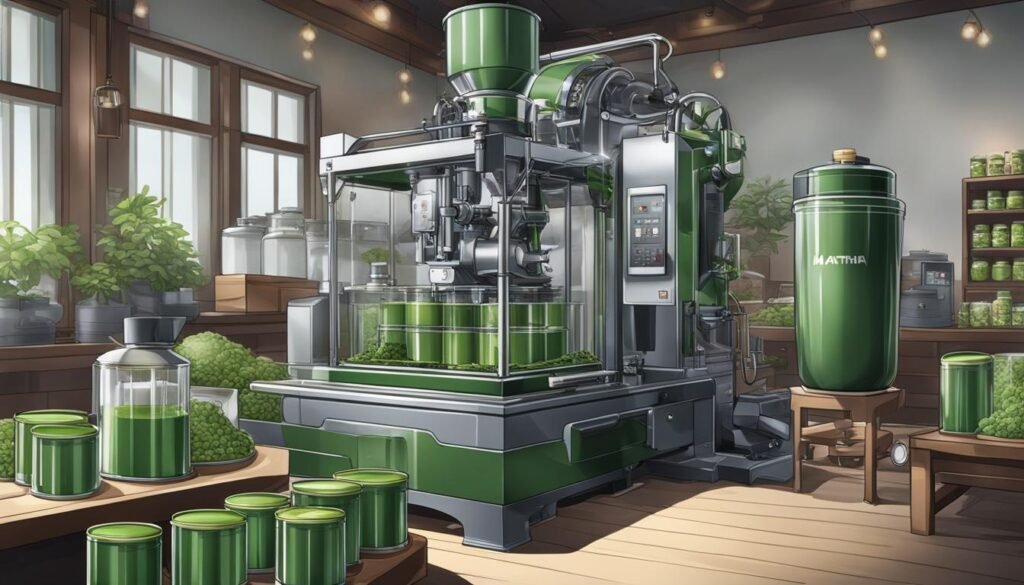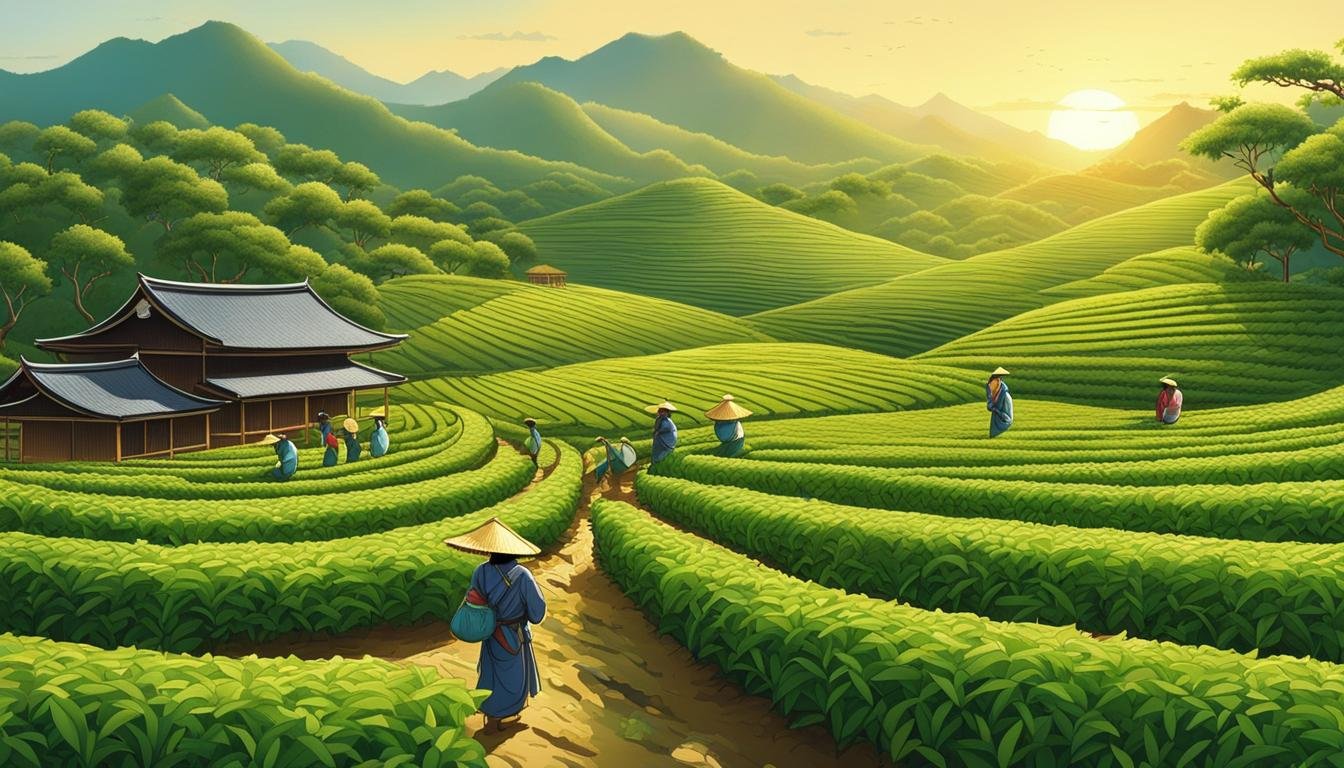Matcha green tea has gained immense popularity in recent years, captivating tea enthusiasts and health-conscious individuals alike. However, one aspect that often raises eyebrows is its price. Why is matcha so expensive compared to other types of tea? In this article, we will delve into the secrets behind matcha’s high cost, shedding light on its production process, market factors, and the reasons behind its growing popularity.
Key Takeaways:
- Matcha’s exclusivity stems from its specific geographic growth locations, primarily in Japan.
- The necessity for first harvest leaves contributes to matcha’s high quality, flavor, and nutrient content.
- Shading techniques and the labor-intensive hand plucking process are essential steps in matcha production.
- Only careful leaf selection and destemming ensure a pure and flavorful matcha powder.
- Expensive grinding equipment and proper packaging add to matcha’s overall cost.
Matcha’s Exclusive Geographic Growth Locations
Matcha, the revered Japanese green tea, owes its exclusivity and quality to the specific geographic locations in Japan where it is cultivated. Japan is renowned for its meticulous matcha farming techniques and centuries-old traditions that have been passed down through generations of skilled farmers.

The unique climate, soil composition, and elevation of these regions create the optimal conditions for matcha production, resulting in a tea with exceptional flavor, vibrant color, and high nutritional content. The careful cultivation and harvesting practices, combined with the expertise of Japanese farmers, make matcha from Japan truly exceptional.
While other countries may attempt to produce matcha, Japan’s matcha remains the gold standard in terms of quality and authenticity. The commitment to maintaining traditional farming practices and the deep cultural significance attached to matcha contribute to its exclusivity and reputation as a top-grade tea.
The Importance of First Harvest Leaves
Premium matcha is made from the first harvest leaves of the tea plant, and these leaves play a crucial role in determining the quality and flavor of the final product. The first harvest leaves are known to be the most nutrient-rich and contain a delicate sweetness that sets them apart from subsequent harvests. This is because during the winter months, the tea plants have a period of rest, allowing them to accumulate nutrients and develop a unique flavor profile.
The limited availability of first harvest leaves contributes to the higher cost of premium matcha. As the demand for matcha continues to grow, the competition for these leaves intensifies, further driving up the price. Farmers meticulously handpick the first harvest leaves to ensure they meet the highest standards of quality. This labor-intensive process adds to the overall cost but ensures that only the finest leaves are used in the production of premium matcha.
The importance of first harvest leaves cannot be overstated. Their exceptional quality and flavor make them ideal for creating a truly remarkable matcha experience. From their rich nutrient content to their delicate sweetness, these leaves are the foundation of premium matcha and set it apart from other varieties of tea.
Shading Techniques and Hand Plucking Process
One of the key factors that contribute to the high price of matcha is the intricate process of shading the tea plants before harvest. This shading technique is crucial as it helps to increase the levels of theanine and reduce the levels of catechins in the leaves, resulting in a sweeter flavor profile. However, this process requires extra labor and resources, as nets and sometimes bamboo scaffolding need to be carefully set up to provide the necessary shade. This labor-intensive method adds to the overall cost of matcha production.
In addition to the shading process, another aspect that contributes to the higher price of matcha is the hand plucking of the tea leaves. Only the young sprouts beneath the third leaf of the tea plant are selected for premium matcha production. Skilled laborers carefully pick these tender leaves, ensuring that only the highest quality leaves are chosen. This meticulous hand plucking process is both time-consuming and labor-intensive, driving up the cost of matcha.
“The shading technique used in matcha production is essential for enhancing the flavor and nutrient profile of the tea leaves. It requires careful planning and attention to detail, but the result is a unique and exceptional matcha experience.” – Tea Master
By employing shading techniques and hand plucking, matcha producers are able to maintain the highest quality standards and ensure that only the best leaves are used in the production process. While these methods may contribute to the higher cost of matcha, they are essential for creating the vibrant green color, rich flavor, and unique characteristics that make matcha a prized and sought-after beverage.
Careful Leaf Selection and Destemming
One of the key factors that contribute to the high price of matcha is the careful leaf selection process. Only the top three sprouts of the tea plant, known for their superior quality in terms of nutrients, flavor, and caffeine content, are used for matcha production. By focusing on these specific leaves, matcha producers ensure that the final product is of the highest possible quality.
Additionally, the destemming process plays a significant role in enhancing the matcha flavor. The stems and veins of the leaves are removed as they can impact the taste of the ground matcha powder. This meticulous destemming process requires specialized machinery, adding to the overall production costs.
Leaf Selection and Destemming: Key Steps in Matcha Production
“Our goal is to bring out the best flavors and qualities from the tea leaves. That’s why we carefully select only the top three sprouts and remove any unwanted stems and veins. It’s a labor-intensive process, but it ensures that our matcha is rich in flavor and has a smooth texture.” – Tea Master, Matcha Farms
The attention to detail in leaf selection and destemming not only guarantees a superior matcha flavor but also contributes to the overall matcha production process. Although it may increase the cost of matcha, it ensures that consumers are getting a premium product that is carefully crafted for an exceptional taste experience.
Next, we will explore the role of grinding equipment and packaging in the matcha production process and how they contribute to the overall cost of matcha.
Expensive Grinding Equipment and Packaging
One of the factors that contribute to the high price of matcha is the expensive grinding equipment used in its production. To turn the destemmed leaves into matcha powder, specialized machinery, such as large granite mills with intricate grooves, is required. This grinding process is not only time-consuming but also produces only a small amount of matcha powder in each cycle. The cost of acquiring and maintaining this equipment adds to the overall expense of matcha.
Furthermore, the packaging of matcha powder also plays a role in its higher price. Matcha is highly sensitive to light, heat, and humidity, which can degrade its quality. To ensure its freshness and preserve its vibrant color, matcha powder needs to be carefully packaged in airtight containers. The additional cost of packaging materials and the extra care taken in handling and storing matcha contribute to its overall pricing.
While the expenses related to grinding equipment and packaging might seem significant, they are necessary to maintain the quality and integrity of matcha. The use of specialized grinding equipment ensures that the matcha powder is finely ground to the desired consistency, resulting in a smooth texture and enhanced flavor. Proper packaging not only protects the matcha from external elements but also prolongs its shelf life, allowing consumers to enjoy its unique qualities for a longer period.

Overall, the use of expensive grinding equipment and the careful packaging of matcha powder are essential aspects of its production process. While they contribute to its higher price, they also guarantee the quality and freshness of the final product. Recognizing the efforts and investments involved in producing matcha helps to appreciate its value and understand why it is esteemed as a premium tea in the market.
Conclusion
The cost of matcha may seem high, but it is justified by the value it offers. From the exclusive geographic growth locations to the meticulous production process, every step contributes to the quality of this unique tea.
Factors such as the use of first harvest leaves, shading techniques, and hand plucking ensure that matcha is packed with nutrients and boasts a sweet, flavorful taste. Careful leaf selection and destemming further enhance the quality of the final product.
Expensive grinding equipment and proper packaging are necessary to preserve the integrity of matcha. These additional costs, along with its limited production quantity and high demand, influence matcha pricing.
Despite its higher cost, many people find the unique flavor, health benefits, and cultural significance of matcha well worth the occasional indulgence. So next time you sip on a vibrant green cup of matcha, remember the expertise and care that went into producing this extraordinary tea.
FAQ
Why is matcha so expensive?
Matcha is known for its high price due to various factors. Exclusive geographic growth locations, first harvest leaves, shading techniques, hand plucking process, careful leaf selection, destemming, and the use of expensive grinding equipment all contribute to the cost. Limited production quantity, high demand, and the need for proper packaging and storage further add to its expense.
Where is matcha primarily produced?
Matcha is primarily produced in Japan, with the country being renowned for its high-quality matcha. Other countries may produce matcha, but Japan remains the leader in terms of quality and expertise.
What are first harvest leaves and why are they important?
First harvest leaves are the initial leaves of the tea plant that have had a period of rest during the winter months, allowing them to accumulate nutrients and develop a sweet flavor. These leaves are the highest in nutrients and flavor, making them ideal for producing premium matcha. Subsequent harvests are lower in nutrients and flavor, hence the limited availability and higher cost of first harvest matcha.
What are shading techniques and how do they affect matcha?
Shading techniques involve covering the tea plants before harvest to increase theanine and reduce catechins, resulting in a sweeter flavor. This process requires extra labor, resources, and the careful setup of nets and sometimes bamboo scaffolding. It contributes to the higher cost of matcha production.
Why is hand plucking important for matcha production?
Hand plucking involves precise picking of young sprouts beneath the third leaf of the tea plant. This careful selection requires skilled labor and ensures that only the top three sprouts, which are the highest in nutrients, flavor, and caffeine, are used for matcha production. Hand plucking contributes to the higher cost of matcha.
What is destemming and why is it necessary for matcha production?
Destemming is the process of removing the stems and veins of the tea leaves used for matcha production. This is done to eliminate any components that can affect the taste of the final ground matcha powder. Destemming requires additional machinery and reduces the overall yield of matcha, contributing to its higher price.
Why does grinding and packaging matcha require expensive equipment?
Grinding the destemmed leaves into matcha powder requires specialized and expensive equipment, such as large granite mills with intricate grooves. The grinding process is time-consuming and only produces a small amount of matcha powder in each cycle. Additionally, matcha powder is highly sensitive to light, heat, and humidity, necessitating careful packaging in airtight containers. The costs associated with grinding and packaging contribute to matcha’s higher price.
Are there any other factors that contribute to matcha’s high price?
Yes, matcha’s high price is also influenced by factors such as its limited production quantity, high demand, and the need for proper packaging and storage. These factors, along with the meticulous production process and the quality of the final product, justify matcha’s higher cost.

